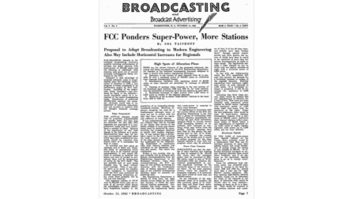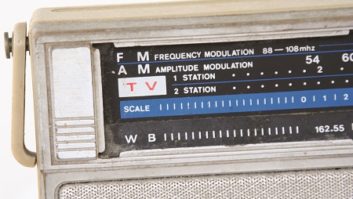A key element of the FCC’s AM rescue plan released in late October is expected to boost the number of FM translators in this country. Some industry observers wonder if this could lead to congestion problems in the FM band.
The FCC’s action on AM revitalization presents AM broadcasters the opportunity to move pre-existing FM translators that are purchased on the secondary market or wait to apply for a new FM translator in an upcoming filing window in 2017.
While there won’t be a net gain of translators until at least 2017, observers think the reshuffling of existing translators beginning next year is likely to bring more translators into more densely populated areas. That could ultimately mean additional interference to existing FM stations even before the 2017 translator filing window, they said.
FOUND IN TRANSLATION?
The commission first authorized FM translators in 1970, with the number jumping in the past decade. There are 6,422 FM translators and boosters today compared to 3,920 in 2005, according to FCC data.
The methods with which the FCC has awarded FM translator licenses has been controversial at times. A notorious 2003 filing window received 13,377 FM translator applications and was plagued by authorization delays. The commission at one point froze the whole process.
Six years ago, the commission began allowing some AM stations to use FM translators to rebroadcast programming as a means to enhance radio service to the public. The power level may not be great, but cross-service translators can provide AMs with access to valuable FM spectrum as well as enhanced nighttime presence.
The FCC says more than 900 AM stations now are rebroadcasting their signals over fill-in FM translator stations. But there are roughly 4,690 AM stations, which is why some experts expect a glut of applications from AM licensees during the translator application windows.
There are 6,688 FM commercial and 4,090 education FMs licensed, according to the most recent FCC data. Add in 1,364 LPFM broadcasters and we can see why there is some concern with increased interference in the FM band going forward.
The National Association of Broadcasters declined to comment on the potential for added interference on the FM band. The group was supportive of the FCC order to revitalize AM radio, according to NAB Executive Vice President of Communications Dennis Wharton.
The FCC is expected to offer several filing opportunities in 2016 for AM stations to relocate one existing FM translator up to 250 miles to operate as a fill-in facility. Class C and Class D AM stations will be eligible to file in the first window for the first six months, with all other AM classes eligible thereafter for an additional three months.
The commission declined to give an estimate on the total number of new FM cross-service translators it expects to see as the result of its plan. Industry experts expect most new FM translators will be in rural areas.
STRETCHING THE LIMITS?
At a minimum, the commission actions are expected to present allocation challenges.
“The recent LPFM filing window really stretched the limits of the rules in the more populated market areas,” said Stan Salek, senior engineer with broadcast consulting firm Hammett & Edison.
For example, the FCC encouraged “sandwiching” LPFM stations on second-adjacent channels between full-service FM stations if a showing of no likely interference could be made, Salek said.
“Many such applications were filed and granted, so I am left to wonder how many more FM translators could be made to fit in urbanized areas. I believe, though, that increased interference to full-service and other FM stations is unlikely unless the FCC makes changes to present allocation policy for co-channel or first-adjacent channel conditions.”
Bert Goldman, president of Goldman Engineering Management, believes FM band crowding in major markets will be an issue.
“It’s going to be a real problem, both for full-service FM stations and for the new translator operators. Full-service stations will need to be vigilant to make sure they don’t lose listeners to aggressively built translators,” Goldman said.


Goldman said there is risk for AM owners who pursue FM translators. “Imagine you’ve just stretched your already tight budget to buy a translator and then paid the money to build, only to find that when you turn the translator on, you are creating impermissible interference to an existing FM station.”
He estimates that a startup FM translator owner could spend thousands of dollars on application fees and equipment — industry estimates are from $20,000 to $30,000 to get a FM translator on the air — only to find out that the new translator is creating impermissible interference to an existing FM. If the interference cannot be resolved, the AM operator ultimately could be required to turn off the translator.
And while power is limited to 250 watts, Goldman noted that for AM fill-in service there is no height limit; assuming a translator otherwise “fits,” coverage and associated interference areas can be significantly greater. So while the absolute number of translators may not increase, spectrum use will increase significantly, especially in more urbanized areas.
The band crowding issue has already begun in major markets, Goldman said, and he anticipates the problem will worsen. “Filling the few remaining holes with FM translators for AM stations will likely complete the crowding process in larger markets. In smaller markets I doubt it will cause much crowding.”
While the rules do not allow the translator to cause prohibited contour overlap interference, the commission has been open to second- and third-adjacent contour overlaps if the applicant can show, on paper, that no “actual” interference will be caused, Goldman said.
Doug Vernier, president of engineering software company V-Soft Communications, said many existing FM stations have listeners outside their protected 60 dBu service contours.
“While the FCC has rules that prohibit interference to a regular listened to FM station outside the protected contour, these rules are difficult to enforce, and the only way the existing FM station can prove interference is occurring is to wait until the translator takes the air and then file with the FCC,” Vernier said.
The translator owner then has time to attempt to correct the interference, he said, which may never happen. “Nevertheless, that translator can stay on the air right up to the moment the FCC issues a cease and desist order, and that often takes years,” he said.
There is also a risk of new translators causing interference to small LPFM stations or other FM translators, Vernier said. “So there is a lot at stake here.”
“OVERCROWDED” OR “COMPETITIVE”?
The industry experts interviewed by Radio World for this story all said it is hard to estimate the number of new FM translators that ultimately will find their way to the FM band and whether they will be located near large markets or more rural areas.
John Garziglia, a communications attorney with Womble Carlyle Sandridge & Rice LLP, said he expects the planned 250-mile filing window in 2016 will substantially reshuffle locations of existing FM translators.
“To the extent that an FM translator moves under the 250-mile waiver, that move will in many cases open up spectrum space at its prior location for an AM station to apply for a new translator under the 2017 auction filing window.”
Garziglia, who has written in Radio World about translators and other topics, said any new or changed service on the FM band brings with it the chance for increased interference.
“However, FM translators will not crowd the FM band any more than have past changes, and will result in more consistent and noise-free reception for many AM stations.
“Those complaining about crowding from FM translators are as likely to be adverse to the competitive threat represented by the enhanced reception of AM station programming as they are to the technical aspects of FM translators.”
Comment on this or any story. Email [email protected] with “Letter to the Editor” in the subject field.






